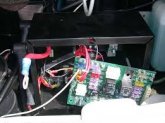Having researched my Motor Home's Battery Control Center (BCC) unit (F73-1020) I have discovered that there is a dynamic battery-charging priority logic built into this BCC. This logic provides that the system gives charge priority to the chassis (starter) battery when the engine alternator is feeding the system and once it reaches full charge the BCC switches charge current to the house batteries.
In the alternative, the BCC feeds shore power and the generator charge current through the converter to the house batteries first and to the chassis battery when the house batteries are fully charged.
If I convert the house battery bank to LiFePO4 batteries...
With the solar system's Charge Controller feeding directly to the house batteries I am afraid that there will be a conflict because the house/chassis batteries are mismatched and their respective charge cycle parameters are different.
I know that the Pb-acid type battery charge profile (that the converter will have resident) cannot hurt the LiFePO4 house batteries because this charge profile will not produce very high current flow, and will not even provide adequate voltage for the LiFePO4 battery. But I do I wonder if the Solar Charge Controller's LiFePO4 charge profile will damage the Pb-acid chassis battery?
Ideas/opinions?
In the alternative, the BCC feeds shore power and the generator charge current through the converter to the house batteries first and to the chassis battery when the house batteries are fully charged.
If I convert the house battery bank to LiFePO4 batteries...
With the solar system's Charge Controller feeding directly to the house batteries I am afraid that there will be a conflict because the house/chassis batteries are mismatched and their respective charge cycle parameters are different.
I know that the Pb-acid type battery charge profile (that the converter will have resident) cannot hurt the LiFePO4 house batteries because this charge profile will not produce very high current flow, and will not even provide adequate voltage for the LiFePO4 battery. But I do I wonder if the Solar Charge Controller's LiFePO4 charge profile will damage the Pb-acid chassis battery?
Ideas/opinions?



